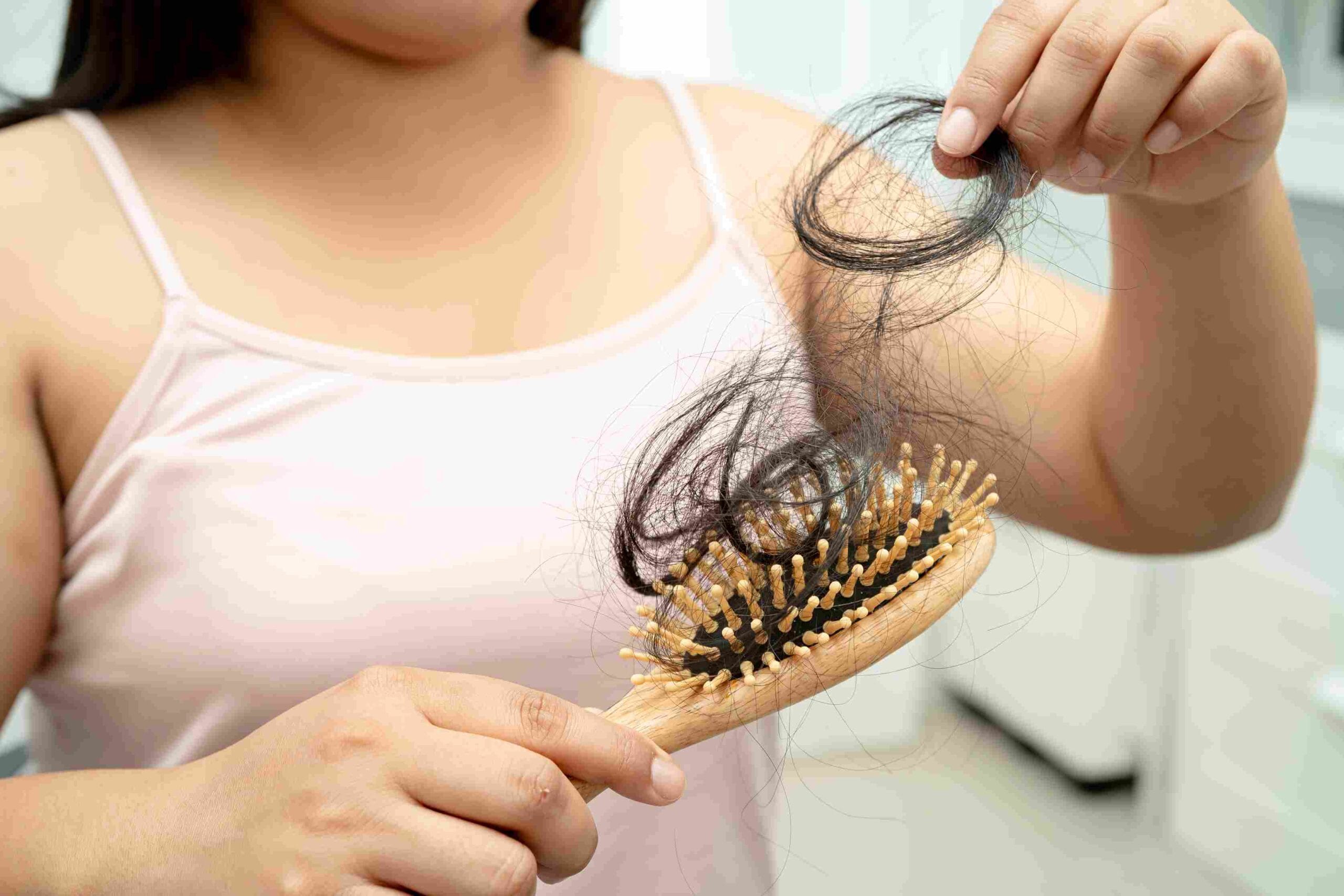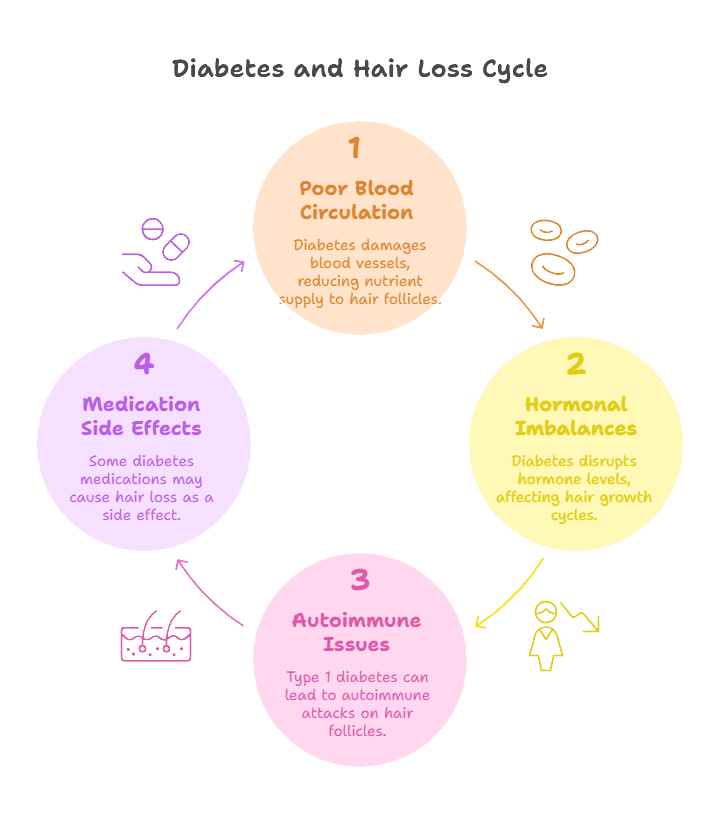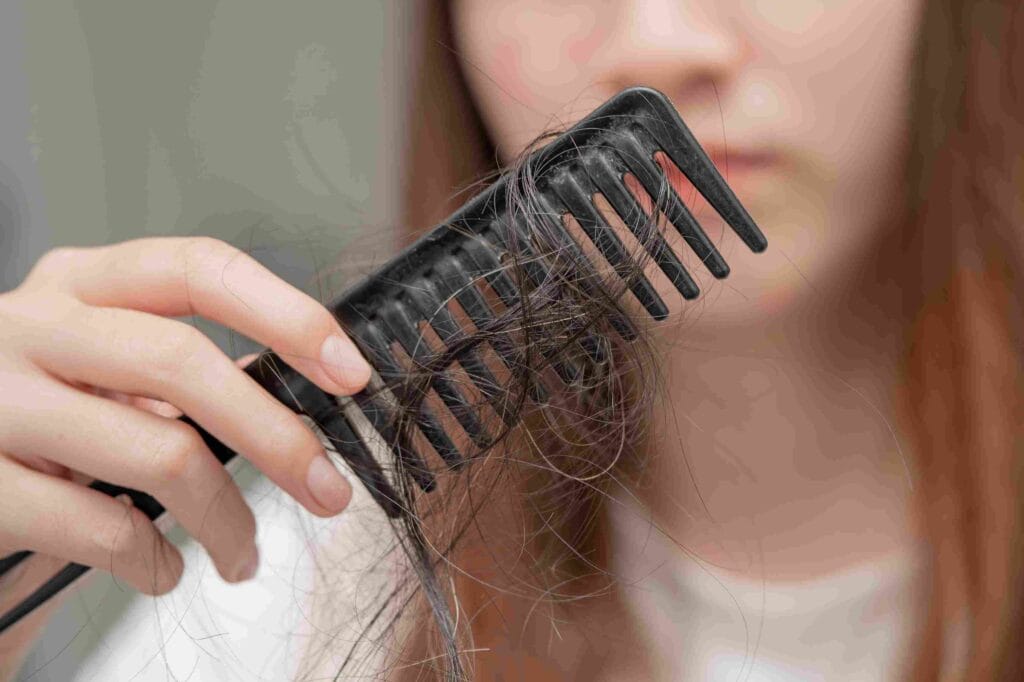
Table of Contents
Introduction: Hair Loss and Diabetes
Can diabetes cause hair loss? Yes, and it’s one of the surprising ways this common metabolic disorder affects more than just your blood sugar. While most people associate diabetes with frequent urination, increased thirst, and fatigue, many are shocked to discover it can also lead to thinning hair and even bald patches.
From a psychological lens, diabetes can have more far reaching consequences than simply being a chronic condition. Out of the 37 million Americans suffering from diabetes, many face the burden of looking in the mirror and noticing extra hair in the brush. Such hair loss can have debilitating impacts on one’s emotional health, self-esteem, and social interactions, which further complicates diabetes as a chronic condition.
Understanding what counts as health-threatening hair loss instead of normal shedding is critical. Evidence suggests that losing 50-100 strands of hair daily is healthy. Anything beyond this mark places an individual at risk as true hair loss (also known as alopecia) occurs when there isn’t sufficient new hair being generated to take the place of old hair that has been shed.
The relationship between diabetes and hair loss may not seem significant at first glance, but it is important to understand this connection when it comes to managing your overall health. If you’ve been diagnosed with diabetes not long ago, or have been living with it for years, it is important to know that higher blood sugar levels could be affecting your hair.
In this post, we will examine the link between diabetes and alopecia further along with the causes, the diabetes-specific alopecia, and the best practices to manage your health and hair simultaneously.
Understanding The Hair Growth Cycle
Your hair does not just sit there; it goes through a cycle of growing, resting and shedding. This is an ongoing cycle that helps keep your hair renewed.
The Main Stages: Anagen, Catagen, and Telogen
- Anagen (Growing Phase): At this stage the magic kicks in. This is the active growth phase where hair on the scalp sprouts for enjoyment purposes, which lasts over 2-8 years. Throughout this phase, a staggering 85%-90% of your hair will usually be getting longer.
- Catagen (Transitional Phase): Furthur, a short pause between the two phases for about 2 weeks. Hair growth stops along with shrinking of the follicle. Only around 1%-3% of hairs can stay in this stage at any one time.
- Telogen (Resting & Shedding Phase): This is the 2 to 3 month period where the hair is at rest before shedding. In this phase roughly between 9% to 15% of your hair is in telogen. It is absolutely normal to lose 50-100 of these hairs daily as new ones are set to sprout.
How Hair Rhythm Can Be Disrupted Due To Diabetes
Now how does diabetes play a role in all this? It can regretfully disrupt this cycle. Shedding and inhibition of new hair growth may occur due to diabetes.
But why this is the case? Consistently high blood sugar levels can damage small blood vessels that supply nourishment to your hair follicles. Picture it as starving the body of nutrients. The follicles could weaken, reducing the anagen (growing) phase and forcing more hairs into telogen (shedding) phase far too early.
Diabetes is believed to interfere at the cellular level as well, explains studies. For instance, it may inhibit Hair Follicle Stem Cells (HFSCs) which are vital for the regeneration of the hair. There is some research that suggests diabetes can trigger inflammatory responses that are harmful to these cells. Critical pathways like Wnt/β-catenin which are needed for the proposed growth of the hair can be silenced by diabetes too. With all these obstructions, your hair would not be replaced optimally after shedding, resulting in noticeable thinning for some people.
The Direct Link: How Diabetes Can Cause Hair Loss
It is a common query amongst many, can diabetes actually lead to experiencing hair loss? The answer is yes, having diabetes can be considered a potential complication. Although not every diabetic patient undergoes hair loss, the ailment does create situations that can heighten the risk of hair loss or increased shedding.
Now, what is happening in the body that could bring this about? Here are some of the ways how diabetes may impact hair that researchers have discovered:
- Poor Blood Circulation: This is a big one. Diabetes, particularly during periods of uncontrolled hyperglycemia, can be extremely damaging to blood vessels throughout one’s body. Your hair follicles are tiny organs that need a good supply of oxygen and nutrients, delivered by your blood, to thrive and produce healthy hair. If the circulation to the scalp is hampered, follicles may be deprived of critical supplies, diminishing their strength and causing hair loss.
- Hormonal Imbalances: Diabetes can affect the hormonal imbalance your body suffers from. Hormones are essential to the proper functioning of the hair growth cycle. For example, insulin problems which is a hormone can affect other hormones that aid in hair growth. These hormonal changes are normally bound within the limits of the hair growth cycle however frequently change in these levels can offset the balance.
- Autoimmune Issues: Patients suffering from type 1 diabetes a condition where *the patient’s body self-destructs insulin creation cells* paitents are likely to get other autoimmune diseases too such as alopecia areata. In this autoimmune disease, the hair follicles which are supposed to be breeding grounds for hair are attacked by one’s immune system. As a result, hair falls out in patches instead of growing continuously.
- Medications: Treatment for diabetes is necessary in form of medication, however some drugs do come with side effects such as hair loss in rare cases. If it does happen to you, you should be seeking medical advice.
As much as the diabetes and hair loss nexus is acknowledged, it is always important to point out that the medical field will still require additional research to comprehensively appreciate how the nuances of this relationship works in broad strokes for every person with diabetes. It is sensible to state that everything does point to the fact that managing one’s diabetes well does help in mitigating risk od complications.
Particular Forms of Hair Loss Linked to Diabetes
Diabetes does have an interesting role to play in some hair loss conditions. Here are some key types that you might hear a lot:
Alopecia Areata
This is an autoimmune disease where the immune system damages the body’s own hair follicles, which leads to the loss of hair that1 oftentimes manifests itself in the shape of bald spots. It can impact the scalp along with other body regions. It is quite important to highlight that some studies are suggesting a link not merely with diabetes. One powerful example is from a nationwide case-control study where it found association of Alopecia Areata with increased odds of prediabetes and obesity. That signals intricate connections between one’s metabolic state, immune system activity, and hair follicles.
Telogen Effluvium
Have you ever noticed increased amounts of hair in the hairbrush or shower after stressful periods or falls ill? That might happen to be Telogen Effluvium. With this form of hair loss, there is a diffuse shedding of hair from the scalp. Underlying it is the past hair cycle changes, which occur after significant stressors (such as severe illness, surgery, or even the ongoing emotional and physical strain of diabetes) push an increased number of hairs into the hair growth cycle resting phase – the telogen phase. The good thing about this condition is that it is distressing in nature, so it tends to be temporary, and hair regrowth is possible after mitigating the underlying trigger.
Central Centrifugal Cicatricial Alopecia (CCCA)
This one should be so noteworthy due to the alarming connections it has with diabetes. CCCA falls under scarring alopecia, meaning it is capable of causing permanent hair loss since the hair follicles will actually be destroyed and replaced with scar tissue. It usually starts in the central crown area of the scalp, and may progress outward over time.
Some of the research, along with a prominent study done on African American women, noted an association between type 2 diabetes and severe central scalp hair loss consistent with CCCA. In that study, the risk was even greater for individuals who had been diabetic for longer periods of time (≥ 10 years), implying a strong association that is important for healthcare providers to actively manage.
Why Diabetes Affects Hair Health: Deeper Mechanisms
Significantly, diabetes impacts hair health through hyperglycemia, or high blood sugar, which is a major contributing factor. Increased glucose levels weaken blood vessels over time, including the small capillaries that deliver oxygen and vital nutrients to hair follicle. This disrupted blood flow leads to poor circulation which, over time, starves follicles leading to slower growth, thinning, and eventually hair loss.
Also note that hyperglycemia is not limited to individuals with diabetes; pre-diabetics, stressed individuals, and some medication users like steroid patients can suffer from high blood sugar due to diet and stress-induced lifestyle changes.
Added to the above-stated causes is diabetes poor blood circulation which is a critical factor lacking in hair nourishments needed by hair follicles for vitality.
Along with this, diabetes is often associated with inflammation throughout the body. This persistent state of inflammation can interfere with some functions in the body, including the hair growth cycle. If you did not know, Type 2 diabetes is associated with thyroid disorders which are known to affect the hair. Another condition with insulin resistance (that can be a precursor to diabetes or diabetes itself), Polycystic Ovary Syndrome (PCOS) is associated with hair loss along with abnormal hair growth.
These diabetes-associated hair health problems are caused by many micronutrient deficiencies. An important one includes zinc, which is vital to hair follicles, and may be lacking in people with metabolic syndrome. Another deficient nutrient is Vitamin B12, most often due to extended use of Metformin, which is known to make hair weaker. Other well-known causes of hair loss include iron deficiency and anemia.
There are also other underlying issues not related to diabetes that can make hair weaker, such as diabetes medication. New evidence points to GLP-1 agonists as possibly causing hair loss, while the other known effect of Metformin hair loss linked to vitamin B12 deficiency further cements the complicated relationship between diabetes control and hair health.
Focus: Type 2 Diabetes and Central Hair Loss in African American Women (Drawing on BWHS)
The Black Women’s Health Study (BWHS) is the first and one of the largest studies focusing exclusively on the health of African American women. It has provided useful information on the relationship between Type 2 diabetes and hair loss. One of the major findings of this observational study was that African American women with Type 2 diabetes have a higher risk of developingcenters cale hair loss, some of them being severely affected.
The multivariable hazard ratio for the risk of hair loss associated with Type 2 diabetes was found to be 1.68. This indicates that the risk was significantly elevated. This became even more pronounced with hair loss developing before the age of 50. Also, when looking only at doctor or biopsy confirmed CCCA, the hazard ratio increased to 2.24, which shows a strong association with this particular scarring alopecia.
The BWHS has numerous strengths (e.g., the large sample size, prospective design permitting assessment of temporality, and careful consideration of confounding factors such as body mass index (BMI), education, smoking, and hair care practices). However, self-assessed hair loss and the lack of biopsy confirmation for all cases, even though the photographic scale used was compatible with CCCA, are limitations.
Notwithstanding the limitations, the conclusion reached in this study is significant. Clinicians need to warn African American women with Type 2 diabetes of the increased risk of central alopecia and suggest more proactive screening.
On the other hand, the absence of central scalp hair in those aged over 40 years may warrant investigation for Type 2 diabetes, suggesting a possible underlying metabolic relationship. The BWHS results highlight the need to consider diabetes as a potential factor in the development of central hair loss in this population.
Analyzing Your Hair Loss: Finding The Root Cause
If you have observed any unusual patterns of hair fall or any variation in the volume of hair, it is a good idea to see a medical professional without delay. It is advisable to see a dermatologist since these medical practitioners have extensive experience in defining and treating different types of hair problems and disorders. Treatment, monitoring, and effective control action can be taken when the problem is diagnosed early.
To find out the cause of your hair loss, doctors typically use the following approach:
- Health History: Your doctor will take full and detailed medical history and record any current health problems, medication, food eaten, amount of stress level, and routine maintenance of hair. This can be very helpful in providing a vital clue or clue aiding in the search.
- Medical Evaluation:Your scalp and hair will be inspected and your hair shedding will be checked for any physical changes in the area. Your scalp and hair will also be checked for other conditions that could affect your hair follicles.
- Additional Procedures: There are cases where additional procedures may be warranted:
- Microscopic Analysis of Hair Samples: This refers to the examination of hair that is shed or plucked by the roots for further examination under a microscope. New studies show that it may be possible to use Hair analysis as a long term marker for blood sugar levels when it comes to glycosylation, and also indicate trace element deficiency marks.
- Trichoscopy: This method involves the use of a handheld microscope to view the scalp and hair shafts of patients suffering from hair and scalp diseases as it provides a magnified view.
- Scalp Biopsy: In inflammatory or scarring variants of hair loss, sometimes a small portion of the scalp is extracted and analyzed microscopically to provide clarity on the definitive diagnosis.
These methods allow the provider to formulate the most likely diagnosis as well as the treatment plan based on the most appropriate treatment for the hair loss.
Management and Treatment Strategies
Tackling hair loss associated with diabetes is a multifaceted approach with optimal management of diabetes being the anchor. Keeping blood glucose levels within the target range is critical because better glycemic control will reduce microvascular damage and improve hair follicles. Patients with diabetes-related hair loss often see some regrowth or stabilization of hair following improvement in HbA1c levels (Source: Journal of Diabetes and its Complications, 2020).
It is equally important to deal with other factors which may be causing hair loss. One other factor includes managing stress as well as PCOS and thyroid disorders. A certain amount of research suggests that there is a significant link between Type 2 diabetes and thyroid disorders. The Journal of Clinical Endocrinology & Metabolism published a study in 2018 which suggests that up to 20 percent of people suffering from Type 2 diabetes also have some kind of a thyroid disorder.
Nutritional support is still critical. Healthy hair growth requires adequate protein and iron. Specific supplements such as Zinc and Vitamin B12 can also be beneficial but only after discussing it with a healthcare professional, especially if the patient takes Metformin, due to increased risk of Vitamin B12 deficiency. Diabetes Care published an article in 2019 stating how longterm Metformin usage will dramatically increase the likelihood of a Vitamin B12 deficiency. Remember to consult a physician before taking these supplements as some can distort thyroid function test results such as biotin.
A range of oral medications and topical solutions can be utilized. For instance, Minoxidil is an over-the-counter solution that may promote hair growth. In certain circumstances, Finasteride, which is prescribed for male-pattern baldness, may also be used. However, for diabetes-related hair loss, the use of Finasteride requires thorough assessment by a dermatologist.
Other options are provided through procedures:
- PRP Treatment (Platelet Rich Plasma): Involves injecting concentrated platelets directly into the scalp with the intention of promoting hair growth. A pilot study in the Journal of Cosmetic Dermatology (2017) reported positive outcomes in patients with alopecia areata.
- Microneedling: Induces collagen production through tiny perforations in the scalp, enhancing the uptake of topical treatment.
- LLLT (Low-level laser therapy): It makes use of low levels of laser lights of certain wavelengths to energize hair follicles. It has been suggested by some studies that hair growth stimulation and sparsity improvement can be achieved (Source: Lasers in Surgery and Medicine, 2014).
- Hair Transplant Surgery: It is a method aimed at restoring the lost hair volume in bald areas. Moreover, it is important to note that in case the reason for baldness, like uncontrolled diabetes, isn’t treated, the surgery may not provide a lasting solution.
Finally, changes to one’s lifestyle, especially stress reduction, regular physical activity to enhance blood flow as well as insulin sensitivity (exercise has been shown to improve insulin sensitivity, a meta-analysis in Diabetologia, 2016), smoking cessation, drinking enough water, and practicing good scalp hygiene will make these supportive measures easier.
Timeline and Expectations
Maintaining reasonable expectations in regard to the timing of results with treatments for hair loss is crucial. Active hair regrowth is a gradual procedure therefore hair restoration is often followed by a period of stabilization that may last anywhere between 6 to 12 months.
However, with some chronic forms, individuals can become aware of subtle visible changes from consistent treatment in two to three months. These time frames are very individual and dependent on the underlying reason for the hair loss, the treatment selection, and personal factors. Following the prescribed regimen is essential during this time.
Also it is essential to know that hair grows in cycles. Because of this cycle, some hair loss symptoms you notice today may actually be the result of a problem that developed underlying months ago. Likewise, even after addressing the cause and initiating treatment, it may take several months before any new growth becomes visible, as the hair follicles require time to recover. This delay is simply a part of the hair growth cycle and is expected.
As such, it is better to manage hair loss concerns as soon as possible. With timely action, the existing hair follicles can be preserved and the rate of hair thinning can be postponed. While immediate effect is not likely, the best opportunity for improvement in the future will result from consistent and appropriate management.
When to book an appointment with a professional.
It must be emphasized again that if you notice any unusual or extreme hair loss, the first step towards addressing these issues should always begin with a medical professional. Even if your blood sugar is well controlled, other issues concerning diabetes or different underlying health conditions might be responsible for hair loss.
For a customized approach to managing your condition, it is advisable to get in touch with a board-certified dermatologist specializing in hair disorders and/or an endocrinologist specializing in hormonal and metabolic diseases, for example, diabetes. These specialists can perform a thorough assessment and advise appropriate tests and treatments based on your needs.
Moreover, it is pertinent to emphasize the important finding from the Black Women’s Health Study: women with central scalp alopecia, in particular, African American women, should be evaluated for Type 2 diabetes due to increased risk of this disease. Early diagnosis of these two diseases opens opportunities for effective treatment.

🚀 Ready to stabilize your blood sugar? Gluco Shield Pro is here! Feel your best every day with this powerful, all-natural formula. Click here to discover your path to balanced health!🌱
Conclusion: Taking a Holistic Approach to Your Energy and Health
To conclude, diabetes is capable of having an impact on one’s hair health, with a number of different factors being responsible for hair loss and thinning. One of the most alarming findings is the link between Type 2 Diabetes and severe hair loss at the vertex with African American women.
The first step is to focus on achieving better hair restoration than managing hair loss through better control of diabetes. Focus on blood sugar control, preservation of vascular function, and reduction of hair follicle damage markers are fundamental. Always remember that optimal teamwork will render the best results. Coordination with the right professionals, treatment of relevant factors, better diet, and therapy all contribute to a stern but sustainable solution.
While the connection between diabetes and hair loss can be concerning, there is hope. With accurate diagnosis, a comprehensive management plan developed in partnership with your healthcare team, and consistent lifestyle adjustments, it is possible to manage diabetes-related hair loss and potentially encourage regrowth. If you’re seeking to explore natural avenues that complement a holistic approach to your overall well-being and energy levels, we invite you to learn more about potential supportive options. Click Glucoshieldpro to delve deeper.









This Post Has 2 Comments
Interesting read! I had no idea diabetes could affect hair health so directly. It’s surprising how interconnected our body systems are—something like blood sugar levels can impact something as seemingly unrelated as hair growth. The emotional toll of hair loss, especially for those already managing a chronic condition, must be overwhelming. I wonder if there are specific treatments or lifestyle changes that can help mitigate this issue for people with diabetes. Also, how early can these hair loss symptoms start appearing after a diabetes diagnosis? It’s great that this topic is being discussed, as it’s probably something many people overlook. What’s your take on balancing hair care with diabetes management—any tips or experiences to share?
Thank you for your comment. Yes, there are certain treatments or lifestyle modifications that can mitigate the problem, including managing blood sugar, eating a healthy and balanced diet, exercising and being physically active, managing stress and not smoking, since smoking damages blood vessels and can impair blood flow to hair follicles. How fast hair loss progresses varies by person. But if you are admiring severe hair fall then immediately meet with your specialist doctor.